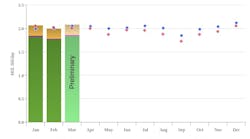The American Petroleum Institute published five new recommended practices (RPs) for the design, construction, and maintenance of structures used in offshore oil and gas drilling and production.
The standards were developed in response to technological improvements making offshore resources that once were inaccessible within reach, said David Miller, API standards director. One standard revises an existing one, while the other four are being published for the first time, he noted.
The five standards are:
• RP 2A-WSD, 22nd Edition, Planning, Designing, and Constructing Fixed Offshore Platforms-Working Stress Design, which serves as a guide for design and construction of new fixed offshore platforms and for relocation of existing platforms used for drilling, development, production, and storage of hydrocarbons offshore.
• RP 2MET, 1st Edition, Derivation of Metocean Design and Operating Conditions, which sets general requirements for using meteorological and oceanographic (metocean) conditions to inform the design, construction, and operation of all types of offshore oil and gas structures.
• RP 2GEO, 1st Edition, Geotechnical and Foundation Design Considerations, which contains requirements and recommendations for applying aspects of geoscience and foundation engineering to a broad range of offshore structures.
• RP 2EQ, 1st Edition, Seismic Design Procedures and Criteria for Offshore Structures, which lists requirements for defining design procedures and criteria for earthquake-resistant fixed offshore structures. It also discusses the effects of seismic events on floating and partially buoyant structures, API said.
• RP 2SIM, 1st Edition, Structural Integrity Management of Fixed Offshore Structures, with specific elements addressing the evaluation of structural damage, inspections above and below the water, assessing fitness-for-purpose, risk reduction, mitigation planning, and the process of decommissioning.
API has been publishing oil and gas standards since 1924, and currently has more than 650 standards and technical publications. The program is accredited by the American National Standards Institute, which also accredits programs at several national laboratories, API said.
